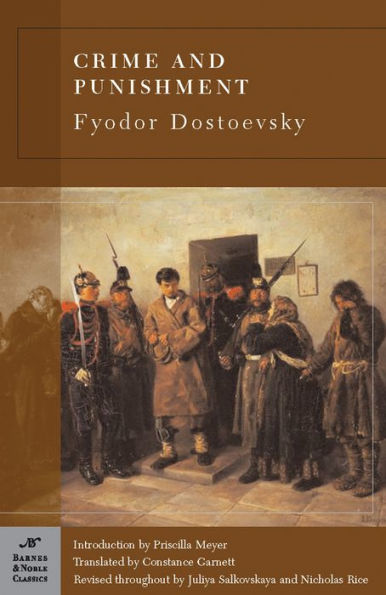Crime and Punishment, by Fyodor Dostoevsky, is part of the Barnes & Noble Classics series, which offers quality editions at affordable prices to the student and the general reader, including new scholarship, thoughtful design, and pages of carefully crafted extras. Here are some of the remarkable features of Barnes & Noble Classics:
- New introductions commissioned from today's top writers and scholars
- Biographies of the authors
- Chronologies of contemporary historical, biographical, and cultural events
- Footnotes and endnotes
- Selective discussions of imitations, parodies, poems, books, plays, paintings, operas, statuary, and films inspired by the work
- Comments by other famous authors
- Study questions to challenge the reader's viewpoints and expectations
- Bibliographies for further reading
- Indices & Glossaries, when appropriate
Few authors have been as personally familiar with desperation as Fyodor Dostoevsky, and none have been so adept at describing it. Crime and Punishment—the novel that heralded the author’s period of masterworks—tells the story of the poor and talented student Raskolnikov, a character of unparalleled psychological depth and complexity. Raskolnikov reasons that men like himself, by virtue of their intellectual superiority, can and must transcend societal law. To test his theory, he devises the perfect crime—the murder of a spiteful pawnbroker living in St. Petersburg.
In one of the most gripping crime stories of all time, Raskolnikov soon realizes the folly of his abstractions. Haunted by vivid hallucinations and the torments of his conscience, he seeks relief from his terror and moral isolation—first from Sonia, the pious streetwalker who urges him to confess, then in a tense game of cat and mouse with Porfiry, the brilliant magistrate assigned to the murder investigation. A tour de force of suspense, Crime and Punishment delineates the theories and motivations that underlie a bankrupt morality.
Priscilla Meyer is Professor of Russian Language and Literature at Wesleyan University, in Middletown, Connecticut. She published Find What the Sailor Has Hidden, the first monograph on Vladimir Nabokov’s Pale Fire, and edited the first English translation of Andrei Bitov’s collection of short stories, Life in Windy Weather.
Crime and Punishment, by Fyodor Dostoevsky, is part of the Barnes & Noble Classics series, which offers quality editions at affordable prices to the student and the general reader, including new scholarship, thoughtful design, and pages of carefully crafted extras. Here are some of the remarkable features of Barnes & Noble Classics:
- New introductions commissioned from today's top writers and scholars
- Biographies of the authors
- Chronologies of contemporary historical, biographical, and cultural events
- Footnotes and endnotes
- Selective discussions of imitations, parodies, poems, books, plays, paintings, operas, statuary, and films inspired by the work
- Comments by other famous authors
- Study questions to challenge the reader's viewpoints and expectations
- Bibliographies for further reading
- Indices & Glossaries, when appropriate
Few authors have been as personally familiar with desperation as Fyodor Dostoevsky, and none have been so adept at describing it. Crime and Punishment—the novel that heralded the author’s period of masterworks—tells the story of the poor and talented student Raskolnikov, a character of unparalleled psychological depth and complexity. Raskolnikov reasons that men like himself, by virtue of their intellectual superiority, can and must transcend societal law. To test his theory, he devises the perfect crime—the murder of a spiteful pawnbroker living in St. Petersburg.
In one of the most gripping crime stories of all time, Raskolnikov soon realizes the folly of his abstractions. Haunted by vivid hallucinations and the torments of his conscience, he seeks relief from his terror and moral isolation—first from Sonia, the pious streetwalker who urges him to confess, then in a tense game of cat and mouse with Porfiry, the brilliant magistrate assigned to the murder investigation. A tour de force of suspense, Crime and Punishment delineates the theories and motivations that underlie a bankrupt morality.
Priscilla Meyer is Professor of Russian Language and Literature at Wesleyan University, in Middletown, Connecticut. She published Find What the Sailor Has Hidden, the first monograph on Vladimir Nabokov’s Pale Fire, and edited the first English translation of Andrei Bitov’s collection of short stories, Life in Windy Weather.

Crime and Punishment (Barnes & Noble Classics Series)
576
Crime and Punishment (Barnes & Noble Classics Series)
576
Product Details
| ISBN-13: | 9781593080815 |
|---|---|
| Publisher: | Barnes & Noble |
| Publication date: | 02/01/2007 |
| Series: | Barnes & Noble Classics Series |
| Pages: | 576 |
| Sales rank: | 255 |
| Product dimensions: | 5.18(w) x 8.00(h) x 1.44(d) |
About the Author
Customer Reviews
Explore More Items
At first glance, Three Lives seems to be three straightforward portraits of women living in the early twentieth century. “The Good Anna” describes an exacting German house servant;
This new edition presents The Grand Inquisitor together with the preceding chapter, Rebellion, and the extended reply offered by Dostoevsky in the following sections, entitled The Russian Monk. By
"one of the most excoriating, compelling and remarkable books ever written; and without question one of the greatest" -- A. C. Grayling (Philosopher, Author, Master of New College of the Humanities)
In 1849, Dostoevsky was sentenced to four years at hard labor in a Siberian prison camp for participating in a socialist discussion group. The novel he wrote after his release, based on notes he
